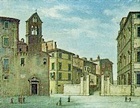Rooms 33
This room was built above Via dei Priori in ca. 1330.
The space on the right is known as the Sala dell' Orologio (Room of the Clock) and provides access to the clock that was inserted in the curtain wall overlooking Corso Vannucci in 1867. In the 16th century, it housed the "Spenditori" (the officials responsible for the provisions consumed in the adjacent refectory (see below). The frescoes on the vaults represent the coats of arms of a number of men who served in this capacity.
Christ Drives the Merchants from the Temple (16th century)
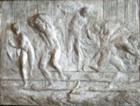
Allegorical female figure (ca. 1573)
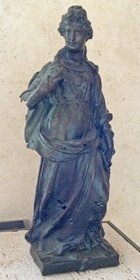
Rooms 34-7
These rooms formed part of the extension that was carried out in 1317-31 to accommodate the Priori delle Arti, and more specifically were used as the living quarters of the Priors.
✴The room to the right of Room 34 (not part of the gallery) served as the Sala del Consiglio. This was the site of the Priors' fateful decision in 1375 to release prisoners of war who later defeated the city. The room was subsequently known colloquially as the Sala del Malconsiglio.
✴Room 36 served as the priors' refectory and Sala dell Udienza (Audience Chamber). A fresco (1493) of the Last Supper by the young Giannicola di Paolo was recently uncovered on the wall of the ex-refectory (see Room 36 below).
Room 34
Virtues (17th century)

These panels from the Oratorio di Sant’ Agostino, which are attributed to Simeone Ciburri, depict:
-
✴the Theological Virtues, Faith, Hope and Charity; and
-
✴the virtue of Mercy (Clemenza).
Miniatures (ca. 1600)

-
✴the Holy Family with angels;
-
✴the Madonna and Child in glory with saints;
-
✴the Holy Family;
-
✴the Assumption of the Virgin; and
-
✴the Martyrdom of St Stephen.
Room 35
Presentation of Jesus (ca. 1580)
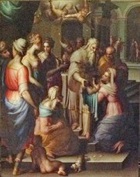
Madonna and Child with St John the Baptist (ca. 1606)
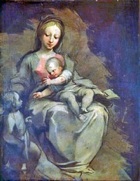
Room 36
Last Supper (1493)
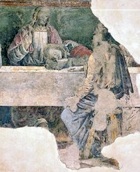
The fresco in Perugia seems to have been modelled on another of this subject in the Convento di Sant' Onofrio, Florence which is usually attributed to Perugino and dated to the period 1485-93. It is possible that Giannicola di Paolo was associated with Perugino in Florence at the time that this (probably) earlier fresco was painted.
Adoration of the Magi (1545)
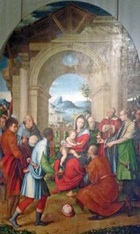
The work was subsequently split into two panels:
-
✴the Visitation; and
-
✴the Adoration of the Magi (illustrated here).
The predella, which had an inscription bearing the date, was subsequently lost.
The two main panels then went their separate ways:
-
✴Dominique-Vivant Denon, the Director of the Musée Napoleon selected the Visitation for confiscation after the Napoleonic suppression of 1810, and it is still in what is now the Musée du Louvre, Paris.
-
✴The Adoration of the Magi remained in Sant' Agostino until 1863, when it entered the gallery.
Adoration of the Shepherds (1579)
Purification of the Virgin (1651)
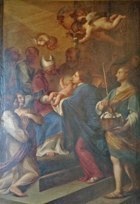
Model of an Equestrian Statue of Orazio Baglioni (ca.1630)
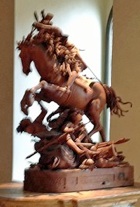
Bust of Marcantonio Eugeni (ca. 1640)
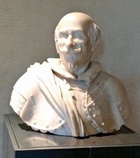
Birth of the Virgin (1643)
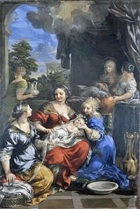
St Martina’s Vision of the Madonna and Child (ca. 1647)
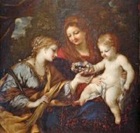
Virgin in Prayer (ca. 1660)
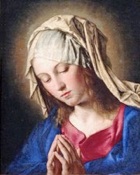
Room 37
Panels from the della Fargna Collection (ca. 1620)
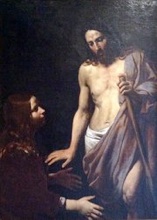
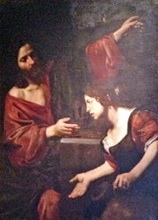
These two panels by Valentin de Boulogne depict
-
✴the scene “Noli me tangere” (in which the risen Christ command St Mary Magdalene not to touch Him); and
-
✴Christ with the woman from Samaria.
They previously belonged to the della Fargna family of Città della Pieve.
St Cecilia and an angel (ca. 1620)
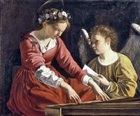
Presentation of the Virgin (ca. 1665)
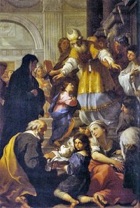
Holy family (ca. 1660)
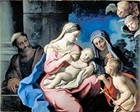
The panel depicts the Madonna breast-feeding the baby Jesus, watched by St Joseph, St Anne, the young St John the Baptist and angels. (Some sources record the old lady in the painting as St Elizabeth, the mother of St John the Baptist, rather than as St Anne, the mother of the Virgin).
St Jerome in his Study (1669)
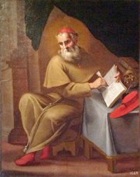
Christ and St John the Baptist (ca. 1685)
This panel, which is attributed to Pietro Montanini, came from the Collezione Sapori. It depicts Christ and St John the Baptist as young boys, with a group of angels, set in a landscape.
Rooms 38-40
These rooms were built around the Torre di Madonna Dialdana in Via della Gabbia in ca. 1333 to provide more space for the Capitano del Popolo.
The windows on the right in Room 38 look down into the Sala del Consiglio, the room of the original palace (1292-6) that was used for meetings of the advisory council. This room was re-designated as the Sala dei Notai in 1583.
Room 38
Martyrdom of St Andrew (ca. 1708)
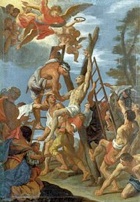
Panels from Palazzo Della Corgna, Città della Pieve (1731)
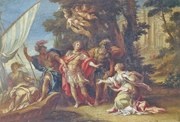
These two panels by Sebastiano Conca depict scenes from the epic poem (1581), “La Gerusalemme Liberata” (Jerusalem Delivered) by Torquato Tasso. They depict:
-
✴the knight Rinaldo leaving the besotted witch Ermida on the island to which she has lured him (illustrated here); and
-
✴the Princess Erminia being cared for by shepherds.
Trinity (1740-2)
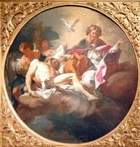
Room 39
Works by Giuseppe Rossi (before 1860)
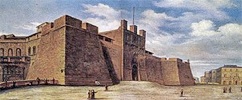
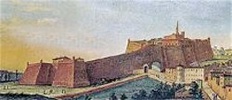

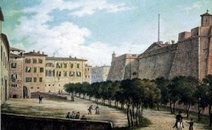
This room contains six of the seven views of Perugia by Giuseppe Rossi that he gave to the comune in 1891. They comprise:
-
✴four views of Rocca Paolina after the moat was filled in but before its demolition in ca. 1860 (illustrated above);
-
✴a view of the stadium that Cardinal Rivarola built century beside the fortified corridor of the fortress in 1805-8, which was used for a ball game known as “gioco del pallone” and for other spectacles, including bull fights (Walk VII); and

A seventh view by Giuseppe Rossi is in the Museo dell’ Accademia di Belle Arti.
View of Rocca Paolina (before 1860)

View of Perugia (ca. 1800)

Room 40
St Pellegrine Laziosi (1705)
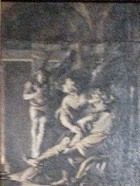
Communion of St Mary Magdalene (1738)
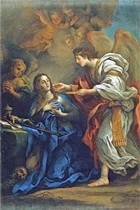
Panels from Montemorcino Nuovo (1745)
The gallery exhibits two preparatory designs by Pierre Subleyras, which relate to altarpieces that he painted for the church of the Convento di Montemorcino Nuovo:
-
✴St Benedict (dressed in the Olivetan habit) revives a dead child; and
-
✴St Ambrose absolves the excommunicated Emperor Theodosius after the massacre of the citizens of Thessalonica.
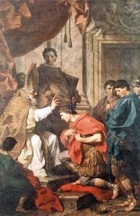
-
✴the altarpiece of St Benedict reviving a dead child (which was signed by the artist and dated by inscription) was sent to the Olivetans’ mother house, Santa Francesca Romana, Rome; and
-
✴the altarpiece of St Ambrose absolving the Emperor Theodosius was transferred to the gallery (and is illustrated here).
Head of a Man (18th century)
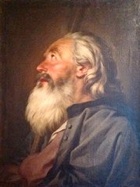
Works from the Carattoli Collection
The artist Giuseppe Carattoli assembled a fine art collection that included a number of works by his teacher, Jean Baptiste Wicar. Giuseppe’s son, Luigi Carattoli donated it to the Accademia di Belle Arti in 1894.
The works from the collection by Jean Baptiste Wicar himself that are exhibited in the gallery include:
-
✴a compete set of preparatory drawings for his the panel (1804) of Pope Pius VII Ratifying the Concordat, in the papal retreat at Castel Gandolfo, including a fine sketch in oil on canvas of the head of Pius VII;
-
✴a sketch in oil (ca. 1821) for an altarpiece of the Risen Christ with SS James and Antony of Padua; and
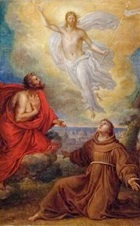
-
✴the so-called Ritratto di Damigella (Portrait of a Bridesmaid), a sketch in oil on canvas (ca. 1809) sometimes said to depict Queen Caroline of Naples. (She was the sister of Napoleon who married Joachim (Gioacchino) Murat, one of her brother’s generals. In 1808, Napoleon appointed them as King and Queen of Naples, positions they held until their deposition in 1815).
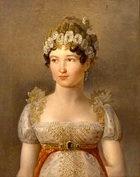
Galleria Nazionale: Sala Podiani and Sala Conferenze Rooms 1-3 Room 4
Rooms 5-6 Rooms 7-10 Rooms 11-16 Room 17 Rooms 18-20 Cappella dei Priori
Rooms 22-28 Rooms 29-32 Rooms 33-40 Deposit
Return to Museums of Perugia.
Return to Walk I.



